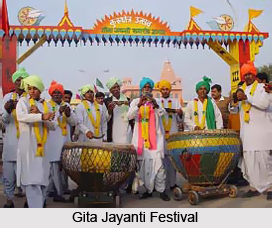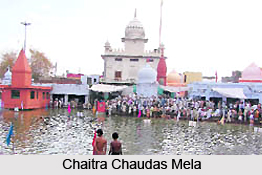 Fairs and festivals of Kurukshetra, Haryana involve a variety of colourful social occasions which are celebrated with gaiety by the regional inhabitants of this part of the country. Some of the most popular festivals of Kurukshetra are `Gita Jayanti`, `Chaitra Chaudas Mela` or `Pehowa`, `Somavati Amavasya`,ISKCON, Lord Jagannath Yatra, `Ratnawali` and solar eclipse.
Fairs and festivals of Kurukshetra, Haryana involve a variety of colourful social occasions which are celebrated with gaiety by the regional inhabitants of this part of the country. Some of the most popular festivals of Kurukshetra are `Gita Jayanti`, `Chaitra Chaudas Mela` or `Pehowa`, `Somavati Amavasya`,ISKCON, Lord Jagannath Yatra, `Ratnawali` and solar eclipse.
Gita Jayanti
The birthday of the `Bhagavad Gita` is referred to as `Gita Jayanti` and it is holy book of the Hindus. This festive occasion is observed in Margaseersha month which falls between December and January, particularly on the 11th day of the waxing moon. It is said that Lord Krishna had revealed the Bhagavad Gita to Arjuna in the legendary battlefield of Kurukshetra above 5000 years ago. Therefore this festival is celebrated to commemorate the birth and creation of this immortal and divine text, in the northern Indian state of Haryana. It is also termed as the Kurukshetra festival, since it is held mainly at this historical place. During this festival, Kurukshetra is visited by innumerable pilgrims from all across India, who participate in the Gita Jayanti. Devotees take a ritual bath in the sacred waters of Brahma Sarovar and Sannihit Sarovar. Several kinds of rites, rituals and religious activities are performed in the Gita Jayanti. Organisations like Information and Public Relations Department, Haryana, Kurukshetra Development Board, North Zone Cultural Centre, Patiala and Haryana Tourism, District Administration organise the Gita Jayanti Samaroh.
Chaitra Chaudas Mela
Every year, the Chaitra Chaudas Mela is arranged in March and it continues till April, on the banks of Saraswati Tirtha Pehowa. A vast number of devotees from different portions of India, especially Haryana and Punjab throng Kurukshetra to take part in Chaitra Chaudas Mela. They participate in significant rituals which involve offering water or `Tarpan` or offering food or `Pind Dan` to their deceased ancestors. It is believed that Pandavas used to perform these religious rituals following the battle of Mahabharata, for the purpose of peace of the souls who were all killed in the battle of Kurukshetra. If the Chaitra Amavasya falls on Monday, the importance of this festival multiplies manifold. The devotees take a holy dip in the holy waters of Saraswati Tirtha and then they proceed to take a bath in Sannihit Sarovar and Brahma Sarovar in the early hours of `Saumauti Amaawas`. Finally, they approach Haridwar to take a dip in Ganga River during the occasion of Kumbha Mela.
Somavati Amavasya
Somavati Amavasya refers to the time of `Amavasya` or the day of the new moon, or no moon`s day which falls on Monday of Somvar. The `Shanti Parva` of Mahabharata states that devotees who takes a dip in holy tanks and rivers during this auspicious day is blessed with peace, prosperity and a life devoid of ailments and anxieties. It is also said that if one takes a dip on this holy days, the soul of the deceased ancestors of the person would attain freedom. On the day when this festival is observed, lakhs of devotees pay a visit to this place, especially the `Tirthas` situated on the banks of Saraswati River. They take a bath in the waters of Sannihit Sarovar and Brahma Sarovar, as well as the tanks of Pandupindara and Ram Rai in Jind District, Haryana. `Maun Vrat` is observed during this day.

ISKCON Lord Jagannath Yatra
The Ratha Yatra is practiced traditionally in Puri, in the state of Orissa, where chariots known as `Rathas` are pulled through the streets to celebrate this festival. However, the Jagannath Ratha Yatra was started in Kuruskshetra for the first time by ISKCON in 1993.
Solar Eclipse
Kurukshetra is thronged by innumerable devotees every year during the time of solar eclipse who take a bath in Sannihit Sarovar and Brahma Sarovar. It is believed that taking a dip in the waters of these tanks would provide as much merit as might have been obtained on performing a thousand Ashawamedha Yajnas. People offer alms to the poor after following the rite of taking a dip in the sacred tanks.



















